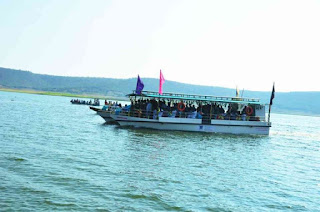Someshwar Swamy Temple (a replica of ancient temple reconstructed as the original place was submerged in reservoir area) a highly revered shrine in Somasila.
There is one more thing that is very big here in Somasila. It’s the festival of Pushkara Snanam where devotees take a dip in the Krishna River, and is considered very auspicious. Here’s the interesting part – the festival is observed once in 12 years!
Boating facilities is available at Somasila in the backwaters of Srisailam Dam.
Tourists can view the scenery around from the open deck while travelling in the boat.
Somasila also has beautiful Haritha cottages, for booking of cottages and boating.
With beautiful surroundings and back waters Somasila is an ideal tourist spot to visit. Somasila is at a distance of 172 kms from Hyderabad.
In order to facilitate amenities for tourists, TSTDC is providing accommodation with good landscaping at the site. There is a restaurant with a 40 seating capacity.
Telangana Tourism department has launched Pontoon Boat services, on Krishna river, from Somasila of Kollapur mandal in Nagarkurnool District to Srisailam.
The boat has been named 'Somasila.' The boat will traverse 110 km in five hours, along the Krishna river.
Tourists can view the scenery around from the open deck while travelling in the boat.
The five-hour boat ride is expected to be a memorable one for nature lovers as the river courses its way through hills and valleys exposing tourists to exotic flora and fauna.
TSTDC to offer a road-river-road circuit which promises combination of a long drive, a pilgrimage, a glimpse of the forest and wildlife and a river cruise with lunch on board.
In weekends, the Tourism Corporation is offering Rs 2,800 per head package to tourists. The fee could include breakfast, lunch, dinner and accommodation. Those who want to travel by launch from Somasila are required to pay an additional Rs 600 per head.
The district offers vast scope for water sports development. It is endowed with waterfalls at Singotam and Yelluru. Other tourist attractions in the district include Sangameswara temple, Somasila temple, ancient temples at Jataprolu and Kadilivanam.
The package includes visit to Mallela Teertham waterfalls and Srisailam dam. Two Harita hotels have been set up – one at Jataprolu and the other at Somasila – at a cost of Rs 99 crore. Arrangements for special boating in Somasila are being made.
The bus takes you from Hyderabad on what holds enough promise to be a memorable journey. After crossing the Forest Department check-post at Mannanur, the first stop is at Farahabad, where a breath-taking viewpoint greets you after a few kilometres stretch of dense Nallamala forest. You whip your camera out and take all the pictures you wish, including ‘selfies’ and ‘vidfies’ with a smartphone.
An hour later it is onwards to ‘Mallela Teertham’, the waterfalls bang in the middle of the Nagarjunasagar-Srisailam Tiger Reserve and then the sight imposing, larger-than-life Srisailam dam and the large water spread too, make visitors shoot more photographs.
After a pass-through that affords a glimpse of ‘Paaladhaara and Panchadaara’, two very thin trickles of waterfall from a height, it is time for a darshan of ‘Sakshi Ganapati’.
As one reaches Srisailam, it is time to check into rooms and quickly freshen up before heading out for a darshan of Lord Mallikarjunaswamy before dinner and getting ready for a night’s sleep. On day two, those interested can have a second darshan at the temple, before going down the ropeway to ‘Paatala Ganga’ to board a boat. The five-hour cruise over the waters of the River Krishna has a visit to Akka Maa Devi temple en route and lunch on board before touching Somasila.
At Somasila, there are a couple of rooms at the Haritha Resort run by the TS Tourism Development Corporation (TSTDC) and take in the serene view of the backwaters, apart from also visiting the Someswara Temple. And then its back to business, to work, on a drive that is bound to be with a few regrets.
All this will be a reality within a fortnight and the road-cum-forest-cum-river-road circuit is bound to attract those in the concrete jungle, says TSTDC Chairman Pervaram Ramulu. He goes on to add this could possibly be a one-of-its-kind combination of a long drive, a pilgrimage, a glimpse of the forest and wildlife and a river cruise with lunch on board.
Development of the Hyderabad-Somasila-Srisailam route. Measures to provide amenities on the Hyderabad-Kollapur route are being looked into. Currently, one trip a week is planned. Daily packages will be implemented depending on the tourist arrivals.
Where to Stay
Riverfront Mrugavani SomasilaOnce at the Riverfront Mrugavani Somasila, the focus of attention is on the ring of low meadowed hills with the river waters kissing them on all edges.
Haritha Hotel, SomasilaThe resort is located on the nook of the land which means the river is completely surrounding the resort. Wake up to great views and piping hot filter coffee! This temple town is around four hours from Hyderabad, and we recommend taking a road trip as you'd pass through scenic vistas.
FOR BOOKINGS CONTACT
Phone No +91-6301857270
Note: The Hotel is leased out to private party. Please contact hotel directly for bookings. Hotel Terms and Conditions apply. Please read terms and conditions of the hotel.
Top attractions in the area
Sangameswara Temple in Middle of the Somasila Water Reservoir
Sri Jogulamba Bala Brahmeswara Swamy Temple (Alampur)
Sri Lakshmi Narasimha Swamy Temple (Singotam)
Madhava Swamy Temple (Kollapur)
Sangameswara Temple in Middle of the Somasila Water Reservoir
Kollapur is at a distance of 9 kms from Somasila is also famous for several temples and can be visited together.
9 km from Kollapur
105 km from Mahabubnagar
186 km from Hyderabad
Sources
http://www.telangananewspaper.com/somasila-boats-from-srisailam-of-mahabubnagar-district/
https://www.telanganastateofficial.com/somasila-srisailam-boat-service/
http://etelangana.org/news/news_details/5801
https://tourism.telangana.gov.in/hotels/SomasilaHotel 















